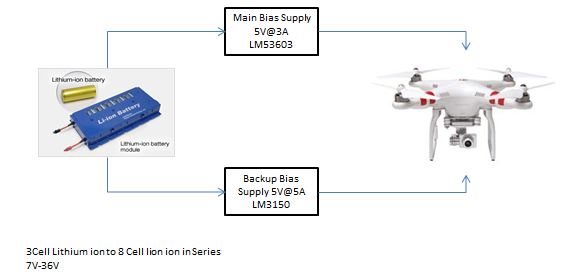The drone industry is expected to grow in the coming years, with an estimate from the Consumer Electronics Association that drone flights will reach 1 million per day by 2035. Applications will be as far ranging as delivering goods from shopkeepers to your doorstep to delivering organs from donors to waiting patients.
The level of business investment is also increasing, with large companies partnering to specifically target the expansion of the consumer drone market. Companies are also lobbying the FAA to allow the use of drones for commercial local transportation of goods, using local street maps as guidance to get to the correct location. What limits the distance that drones can travel is the expected payload plus the weight of the drone and the size of the power source, which is a combination of batteries.
Figure 1: A drone in action.
Drones have several design challenges (example in Figure 1). Engineers must consider how far the drone is expected to fly and how long it will be operational, along with other factors like propeller efficiency and wind drag. All of these play a factor in terms of what the drone will look like, and its expected performance.
Drones typically have two electronic boards; these are separated to make the manufacturing simpler and to accommodate the electronics into the drone’s shape and design. The body itself is typically foam – used because it is as light as possible but still rigid enough to not distort in flight or break upon landing. The motors are typically brushless DC motors, connected directly to a battery pack. Each arm of the drone can be driven independently, with speed control integrated to manage level flight. Because the battery packs have to be incorporated into the drone’s frame, designers often use lithium polymer cells to ease forming to the area allotted for them. These types of batteries also have a very good power-to-weight ratio.
Two main PCB boards contain the electronics: the main one is the motherboard and the secondary is the navigation board. The motherboard could include a processor, CMOS camera, Wi-Fi, USB and memory. The navigation board might combine stabilization and altitude control, using ultrasonic altimeters and MEMS gyroscopes.
As drone design can vary significantly in terms of size, power and shape, there is a need for a flexible power supply to operate the motherboard. It isn’t practical to design multiple power supplies for different drones, as this can be time-consuming and difficult to manage in terms of system implementation. The power supply needs to be very reliable and also offer fast transient performance because of the large amount of multiple sensor data and high-power DC motor control.
Due to a drone’s ability to easily access many locations during operation, the power supply should include a second redundant power supply as a safety feature for carrying loads or flying in populated areas so that the drone can land safely or be recovered in flight when issues occur. Nobody wants a drone to fall on their head or cause an accident with another vehicle.
TI has designed a reference design to support these power-supply challenges. The High Density Efficient Solution for Main Aux as well as Backup Aux Power in Drones TI Designs reference design (Figure 2) is a high-power-density 40W buck-converter design optimized for wide VIN using the LM3150 controller integrated circuit for the drone’s backup power) and LM53603. The design accepts an input voltage of 7VIN to 36VIN and provides outputs of 5V at 5A for drone backup power and 5V at 3A for drone main power. It features a small size and is an inexpensive and very efficient solution to drone design challenges.
Figure 2 – Power-supply block diagram for drones.
The LM3150 was used in the reference design because it has a wide VIN, fully synchronous constant on-time (COT) architecture that offers very fast transient performance to supply the drone’s core processor. Being a controller, it has the ability to drive high power density, and when incorporated with a low RDSON MOSFET like the CSD18563Q5A can provide up to 95% efficiency (Figure 3). The LM53603 is also a fully synchronous current-mode architecture that offers high levels of integration (integrated low-side FET) and high-frequency operation while occupying very small real estate on the PCB. Both approaches offer the ability to achieve a high level of power density, efficiency and cost optimization. Because the LM53603 and LM3150 have been designed to support wide VIN ranges, they can scale from three cells to eight cells without power-supply optimization or changes. They are well-suited for a module approach to a drone’s varying system needs.
Figure 3 – High-density power supply reference design for drones and efficiency curves.
Additional resources:
- Download the High Density Efficient Solution for Main Aux as well as Back up Aux Power in Drones TI Design reference design and get started quick.
- Consider these TI products for your next design:
- Read more blogs about drones:
- Rise of the drones: https://e2e.ti.com/blogs_/b/fullycharged/archive/2015/06/24/rise-of-drones.
- When it comes to batteries, the sky’s the limit: https://e2e.ti.com/blogs_/b/fullycharged/archive/2015/08/15/when-it-comes-to-batteries-the-sky-s-the-limit.
- Precision farming with flying farmers: https://e2e.ti.com/blogs_/b/industrial_strength/archive/2015/09/03/precision-farming-with-flying-farmers.



